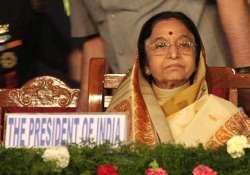President Refers Justice Sen's Resignation To Justice Dept
New Delhi, Sept 2: President Pratibha Patil has referred to Department of Justice the resignation of Calcutta High Court judge Justice Soumitra Sen five days before the Lok Sabha was to take up an impeachment

New Delhi, Sept 2: President Pratibha Patil has referred to Department of Justice the resignation of Calcutta High Court judge Justice Soumitra Sen five days before the Lok Sabha was to take up an impeachment motion against him as it was not in proper form.
The President's decision came amid a debate among legal and constitutional experts as to whether or not the Lok Sabha should proceed with the scheduled impeachment proceedings next Monday after Sen's resignation.
Justice Sen had faxed his resignation to the President yesterday to perhaps avoid the ignominy of becoming the first judge to be impeached by Parliament but according to the rules, the letter needs to be in his own handwriting and not in copy form, official sources said today. The sources said the President referred the resignation to the Justice department with a note that faxed resignation is not acceptable and it needs to be in original and signed in his own handwriting.
In Kolkata, Sen's lawyer Subash Bhattacharya said the resignation letter in original has been signed by the judge and sent by courier to the President and Speaker Meira Kumar. The Rajya Sabha has already passed the motion against Justice Sen, the first judge to have been impeached by the Upper House for misconduct.
Justice Sen was found guilty of misappropriating Rs 33.23 lakh under his custody as a court-appointed receiver in the capacity as a lawyer, and misrepresenting facts before a Calcutta court in a 1983 case.
In his letter to the President, Justice Sen said, “I am not guilty of any form of corruption”.
Minister of State for Parliamentary Affairs Rajiv Shukla felt there is no scope for any discussion in the Lok Sabha but said the Government would have to ascertain the rules on the issue before any decision is taken.
“I don't think there is any scope for discussion now, after Justice Soumitra Sen's resignation,” Shukla told reporters in Delhi.
Legal and constitutional experts said Sen's resignation has put the ball in President's court since she has to now decide whether to accept his resignation or leave it to the Lower House to proceed with impeachment proceedings.
The procedure for removal of a judge has to be completed in the same session of Parliament. It is now left to the President whether to accept the resignation or keep it pending for the process of removal of the judge to be completed, said noted jurist Ram Jethmalani and former Lok Sabha General Secretary Subhash C Kashyap.
Slightly differing with them was former Chief Justice of India V N Khare and Constitutional expert Anil Divan who said “President is bound to accept the resignation unless there is something against him” and that the motion becomes infructuous on resignation of a judge.
“If his resignation is accepted immediately, then there is no question of removal. Where is the question of removal if he has already gone out?” said Divan adding that “As far as removal is concerned, it becomes infructuous since he is no more a judge. What is the point of removing a non-existent judge, if he has already resigned?”
The view was shared by Khare, who said “there should be a relation between the motion of removal and his office”. However, Kashyap said, “it is a grey area whether in all cases, the President has to accept the resignation.”
“When the process of removal of a judge is initiated and one House has already held him guilty and the Lower House has to take up the matter, whether resignation is bona fide or not is to be decided by the President,” he said.
On what would happen to the motion in the Lok Sabha, Jethmalani said “well, personally, I think that the Lok Sabha has the jurisdiction to proceed because there is a difference between removal and resignation.”
“There will be an order from the President for removal.” On whether the president has the choice not to accept Sen's resignation, Jethmalani said, “Of course”. Kashyap said the President is left with three alternatives.
First, he said as per decision of the Supreme Court in 1978 in Gopal Chandra's case if three conditions (resignation by own hands, addressed to the President and categorically stating his resignation from the office) are fulfilled the person ceases to be in office.
Second is that the President keeps the matter pending and wait for the process of removal to be completed in both the Houses.
Third alternative is political in which the politicians decide to let the matter die its own death on the grounds that due to paucity of time the matter could not be taken up in this session. PTI